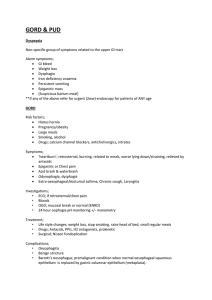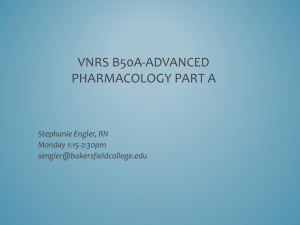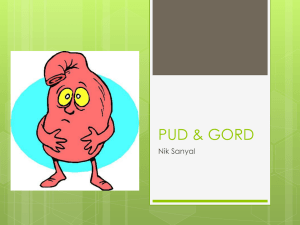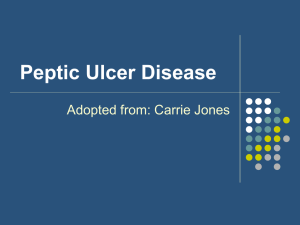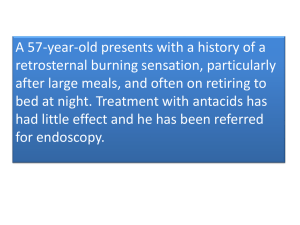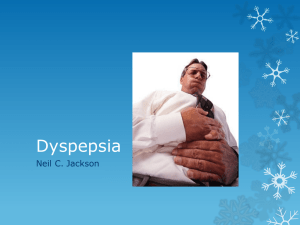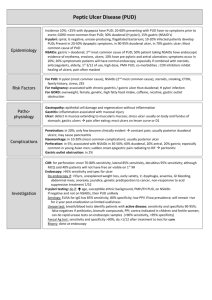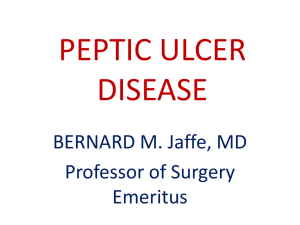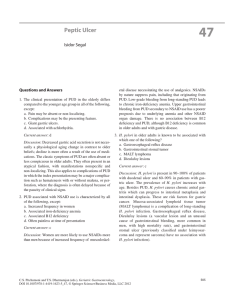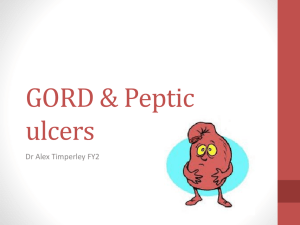Peptic ulcer disease
advertisement
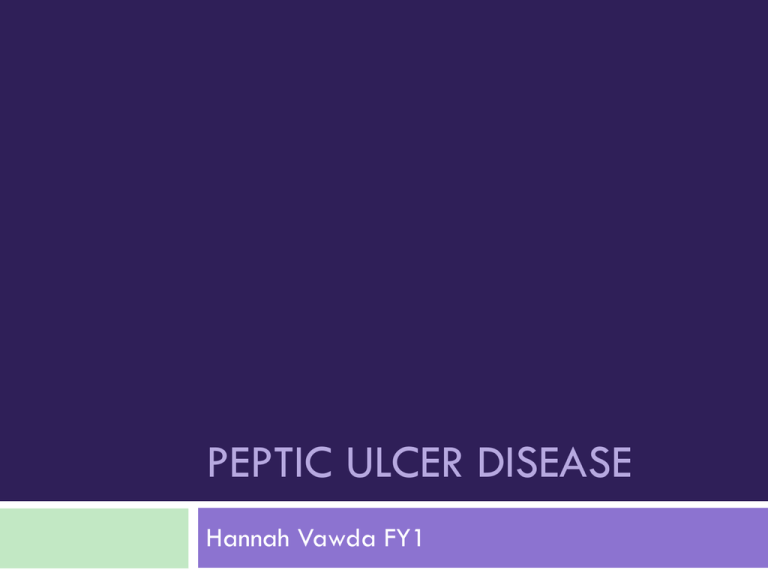
PEPTIC ULCER DISEASE Hannah Vawda FY1 Objectives Definition of peptic ulcer Comparison of duodenal & gastric ulcers Aetiology Clinical presentation Management Emergency scenario What is a peptic ulcer? Peptic ulcer A break in superficial epithelial cells penetrating down to muscularis mucosa Differences between duodenal & gastric ulcers? DUODENAL INCIDENCE ANATOMY DURATION (acute/chronic) MALIGNANCY GASTRIC Duodenal vs Gastric DUODENAL GASTRIC INCIDENCE More common Less common ANATOMY First part of duodenum – anterior wall Lesser curvature of stomach DURATION Acute or chronic Chronic MALIGNANCY Rare Benign or malignant Taking a history I What risk factors would you ask about in the history? Risk factors HELICOBACTER PYLORI Non Steroidal Anti-inflammatory Drugs Steroid therapy Smoking Excess alcohol intake Genetic factors Zollinger Ellison syndrome – rare syndrome caused by gastrin-secreting tumour Blood group O Hyperparathyroidism H Pylori Urease producing, gram negative bacillus Developing countries Infection increases with age Infects mucosa of stomach > inflammatory response > gastritis > increased gastrin secretion > gastric metaplasia > damage to mucosa > ulceration Increased risk of developing gastric adenocarcinoma Taking a history II Take a focused history Taking a history 55 yr old man presents with a 6-month history of worsening epigastric pain described as a burning sensation. He notices the pain is worse when he is hungry. He feels nauseated with the pain but has not vomited. There is no change in his bowel habits and his weight is more of less stable. He smokes 10 cigarettes a day and drinks socially. He has been to see his GP who has suggested ranitidine but this has not helped. On examination he is tender in his epigastrium but examination is otherwise unremarkable. Differential diagnoses for epigastric pain Surgical Biliary colic, acute cholecystitis Pancreatitis Perforation of viscus Acute appendicitis Malignancy Medical GORD MI PE Pneumonia Symptoms of PUD Asymptomatic Epigastric pain Nausea Oral flatulence, bloating, distension and intolerance of fatty food Heartburn Pain radiating to the back ALARM signs for epigastric pain Chronic GI bleeding Iron-deficiency anaemia Progressive unintentional weight loss Progressive dysphagia Persistent vomiting Epigastric mass Patients aged 55 years and older with unexplained and persistent recent- onset dyspepsia alone Management of dyspepsia NICE guidance for dyspepsia Investigations H pylori testing H pylori testing C urea breath tests Stool antigen tests Serology Endoscopy with biopsy H pylori treatment 7-day, twice-daily Use a PPI, amoxicillin, clarithromycin 500 mg (PAC500) regimen or a PPI, metronidazole, clarithromycin 250mg(PMC250)regimen. Do not re-test even if dyspepsia remains unless there is a strong clinical need. Emergency scenario A 50 year old man is brought into A+E via ambulance. He is vomiting bright red blood and complaining of abdominal pain. You get a quick history from his wife who explains he suffers with heartburn and is on lansoprazole. He was out with his work mates last night and drank quite heavily. Initial Management I ABCDE approach Call for help Initial management II Airway is clear Breathing – RR 30 breaths/min, Sats 91% OA Circulation – HR 130 beats/min, BP 80/40 mmHg Protect airway & keep NBM High flow oxygen Gain access – 2 large bore cannulae Bloods- FBC, U&Es, LFTs, glucose, clotting, cross match 6 units Catheterise to monitor urine output Initial management III If shocked prompt volume replacement Either colloid or crystalloid solutions Red cell transfusion should be considered after loss of 30% of the circulating volume Correct any clotting abnormalities Urgent endoscopy after resuscitation Acute upper GI bleed Common, 10% mortality Common causes: PUD, varices Endoscopy: primary diagnostic investigation & allows for treatment Assess using the Blatchford score at first assessment and full Rockall score after endscopy Rockall score Summary A peptic ulcer is a break in superficial epithelial cells penetrating down to muscularis mucosa Duodenal > gastric ulcers Can be asymptomatic H pylori is a predominant risk factor H pylori diagnosed by c urea breath test, stool antigen or if validated serology, treated with PAC500 or PMC250 regime Complications of PUD can lead to acute emergency of upper GI bleed

